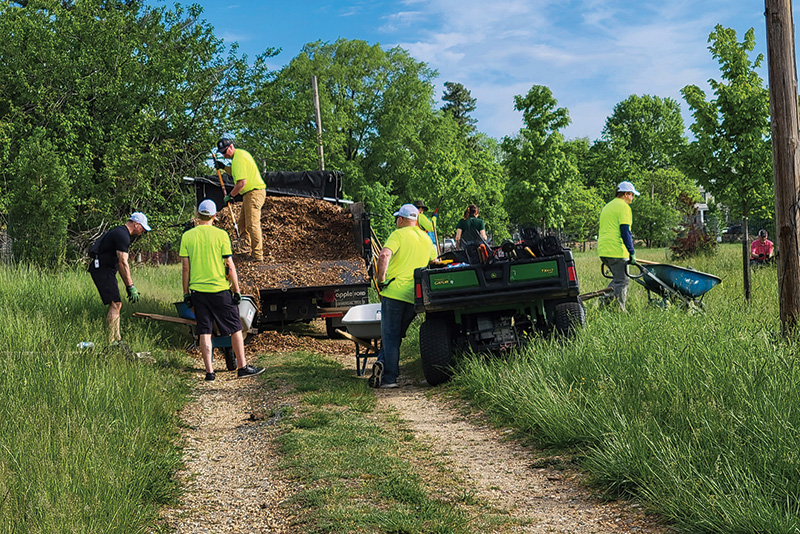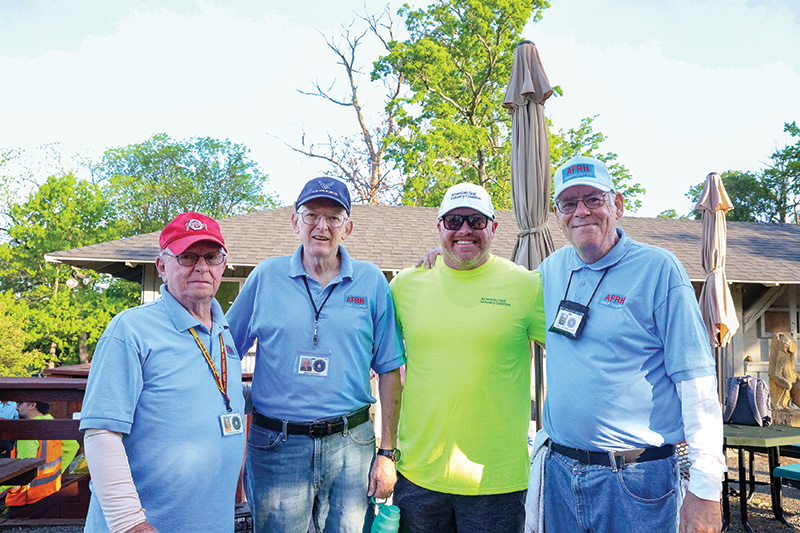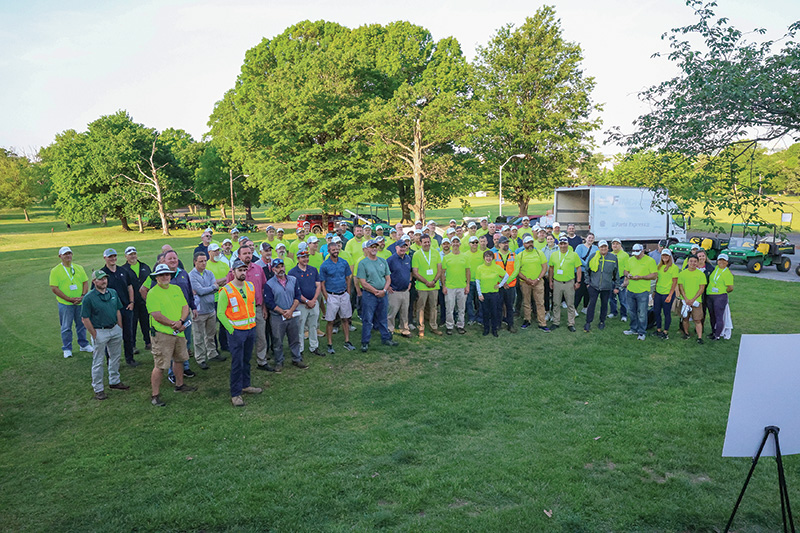
National Golf Day volunteers begin work at the Old Soldiers Golf Course in Washington, D.C. Photos by Tyler Stover
Milton Stark would be the first to admit that, until recently, he knew little about what it takes to maintain a golf course.
“I know nothing about golf courses,” he says. “I don’t golf. This was just the opportunity to be outside.”
Imagine, then, how Stark — golf course manager at the Old Soldiers Golf Course on the grounds of the Armed Forces Retirement Home in Washington, D.C. — felt when dozens of golf-industry volunteers, the vast majority of them in golf course management, descended on Old Soldiers GC as part of the community service project affiliated with National Golf Day.
“I was blown away by the number of people who were here,” Stark says. “They showed up with probably 30 pieces of nice equipment — mowers, aerifiers. They aerified and seeded all our greens for us and mowed every single blade of grass that we have here. They trimmed, weed-eated, mulched. There were over 100 of them, and over three hours, they accomplished every single thing on their list they wanted to do.
“I think we were looking pretty good to begin with, but then they came in. They mowed everything that could be mowed, pulled weeds, trimmed trees, just making things look much, much better than what it did. It’s looking pretty good.”
‘It looked terrible’
That wasn’t the case when Stark, 83, and his wife moved to the AFRH in March 2023. A Navy veteran of 23 years who spent most of his time on diesel-electric submarines, Stark wasn’t much interested in the nine-hole golf course that is listed among the property’s top amenities.
The volunteer in charge at the time was ill, and he wasn’t able to maintain the course as he would have liked.
“It looked terrible,” Stark says. “Stuff was grown up everywhere. When it was supposed to be mowed, it wasn’t mowed right. We didn’t know it at the time, but he was battling pancreatic cancer and was going through chemo treatments. This guy asked me, ‘Do you know anything about mowing?’ I’d run a couple of pretty good lawnmowers before, so he said, ‘Let me show you.’”
Stark climbed aboard a 104-inch Hustler mower, and after receiving a few instructions, his die was cast.
“That was the start of it all,” he says.
Stark enlisted three other residents — volunteers, like him — to fill out his crew, and they rolled up their sleeves.
“We just started mowing and cleaning up,” Stark says. “There was so much overgrowth — trees, weeds. We just started working. It’s a good place to get out and stay active. The four of us together had the mindset that this place is actually giving a lot to us, and we needed to give back. That’s what it’s really all about.”

GCSAA President T.A. Barker, second from right, poses with Armed Forces Retirement Home representatives, from left, Milton Stark, Brad Marshall and Paul Armbruster.
‘A hidden gem’
The AFRH and its course have interesting histories.
The AFRH technically is an independent agency overseeing two separate facilities that house former members of the U.S. armed forces and their spouses. It was the result of a merger between the former United States Soldiers’ and Airmen’s Home in Washington and the United States Naval Home in Gulfport, Miss. Those predecessor properties trace their history back to the early 1800s, though the AFRH-Gulfport originated as a naval “asylum” in 1834 before relocating to a 40-acre parcel on the Gulf Coast.
AFRH-W, on the other hand, is located on 240 acres of prime D.C. real estate less than 5 miles from the Washington Monument. Several historic sites remain on the property, including President Lincoln’s Cottage, a National Landmark that Abraham Lincoln used as a summer retreat while he was president.
“I think it’s an incredible greenspace in the community,” says Marine Robbins, an AFRH public affairs specialist. “It’s really a sanctuary for all the veterans who live there. It’s a hidden gem, a parkland right in the middle of the capital. There are tee boxes where you stand and you’re looking at the Washington Monument. You can see the Capitol. You can watch the presidential helicopters go by. It’s really an incredible place to be.”
The course had been professionally managed until about 15 years ago, Robbins said, when the decision was made that government funds would no longer be used for its upkeep.
“That’s when it became an all-volunteer force,” she said. “We lost the employee who was in charge of running the course, and it was turned over to the residents. Over the years, folks became less and less knowledgeable about how to maintain it. It fell into disrepair, but not because it wasn’t loved.”
Skeleton crew
Robbins says the work done by Stark and his small, roughly octogenarian crew has been “incredible, a real labor of love,” but they have their limits.
“Right now, there are five of us, and we work almost every day,” Stark says. “But we’re all getting up there in age. When I say we work every day, for some guys, that’s two, three, four hours, then they’ve done enough for today. A couple of us put in a few more hours, but it’s almost every day, all week long. That’s our work week.”
Two of the crew do play golf, but three do not. Stark is among the nongolfers.
“This gets me outside,” he says. “It keeps me busy. My wife takes care of the flowerbeds. It’s a beautiful place, and I get to help make it look even better.”
Folks living outside the fence — “We call them civilians,” Stark says — can play the course. For $600, course “members” can play anytime during the May 1-Nov. 30 season. There are no established tee times, and Stark says 175 associate members have paid dues this year.
“If you know anything about golf in Washington,” he says, “you know you can’t go anywhere on a golf course for $600 for six months.”
Those monies go into a fund for residents. That fund pays for parties, bus trips to the commissary — “All those things are paid for by the residents’ fund,” Stark says — as well as course maintenance essentials, like gas for the mowers.

NGD volunteers gather before being turned loose to tidy up the Old Soldiers Golf Course.
Ongoing assistance
John Lobenstine, GCSAA Class A director of agronomy for the Montgomery Valley (Md.) Revenue Authority, which owns and operates nine public courses in the D.C. Metro area, has been on the National Golf Day Planning Committee since 2017. Traditionally, the community service project included clean-up work on the National Mall, but Lobenstine — a 26-year association member — noted that a scheduling snafu prevented a trip there for this year’s NGD, which ran April 30-May 2.
A contingent of volunteers also helped out at East Potomac Golf Links as part of the community service project.
“We had talked about going out to the Old Soldiers Golf Course before,” Lobenstine said. “This allowed us the wonderful opportunity to help them out this year. They’re all veterans with no formal training. It was super rewarding to meet them. They were so incredibly grateful, and it was very rewarding for us. It was a lot of fun.”
The aerification the volunteers performed was the first on the course in years, Stark says.
“The reason we haven’t is none of us who work on the golf course even know what that is,” he says.
Stark says Lobenstine is among the handful of local superintendents who since have returned — and who plan to return throughout the season.
“They’re giving us more information, some hints about how to take care of our greens,” Stark says. “They said, ‘Since we’re in the area, we’ll be back about every other week to look at things with you and help you along.’
“You know, greens are one of the most important areas of a golf course, so they jumped right in there and gave us some tools and some hints to help the greens come along, plus their expertise. They’re getting better and better, and we’re so happy they came to help.”
Andrew Hartsock (ahartsock@gcsaa.org) is GCM’s editor-in-chief.